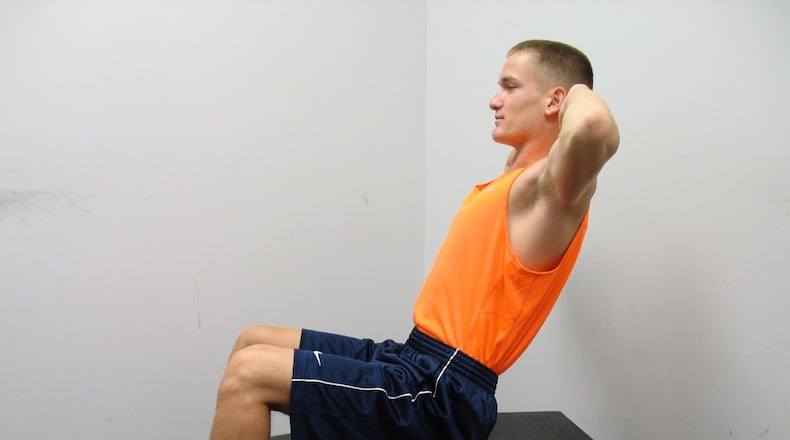TO PERFORM:
While seated in an upright position, place fingertips behind the neck. Look straight ahead, and to prevent slouching, maintain a neutral spine, meaning that the natural curves of the spinal column are held in place throughout the exercise.
Slowly lean backward. You should feel the abs tighten. Do not round the back or let the feet leave the floor. Pause briefly before returning to an upright position. If using a chair, try to sit far forward enough so when you are leaning, you will not touch the back of the chair.
VARIATIONS:
If you find the Seated Crunch too difficult, instead of placing the fingertips behind the neck, fold the arms across the chest. On the other hand, if not challenging enough, hold a dumbbell or other weight at arms length to increase resistance.
To incorporate the obliques (sides of the waist), twist slowly to one side and then the other, while in the reclining position.
To target more of the lower abdominals, lean back and lift both feet from the floor, bringing the knees as far toward the upper body as possible. The greater the bend at the knees, the easier, so for a greater challenge, work toward keeping legs straight or nearly straight while lifting them from the floor.
TIPS:
Beginners should start with 1 to 2 sets, performing as many repetitions as possible with good form. As always, if you have pre-existing medical conditions or are unaccustomed to exercise, check with your doctor before starting a fitness program.
It is not necessary to perform abdominal exercises every day. Instead, work the muscles to fatigue and then give them a day or two of rest before repeating, as you would any other muscle group. If you have achieved a strength level that you are satisfied with, you can perform abdominal exercises each day, but this would be for the purpose of maintaining, rather than increasing, strength. Simply put, to gain strength the muscles must be worked to a level where they need proper recovery time.
Last but not least, remember, you that you cannot spot reduce. The purpose of resistance training is to strengthen the body and help it function at its best. To reduce the size of the midsection, it is necessary to consume a calorie appropriate diet and get sufficient aerobic activity along with regular strength training workouts.
About the Author
